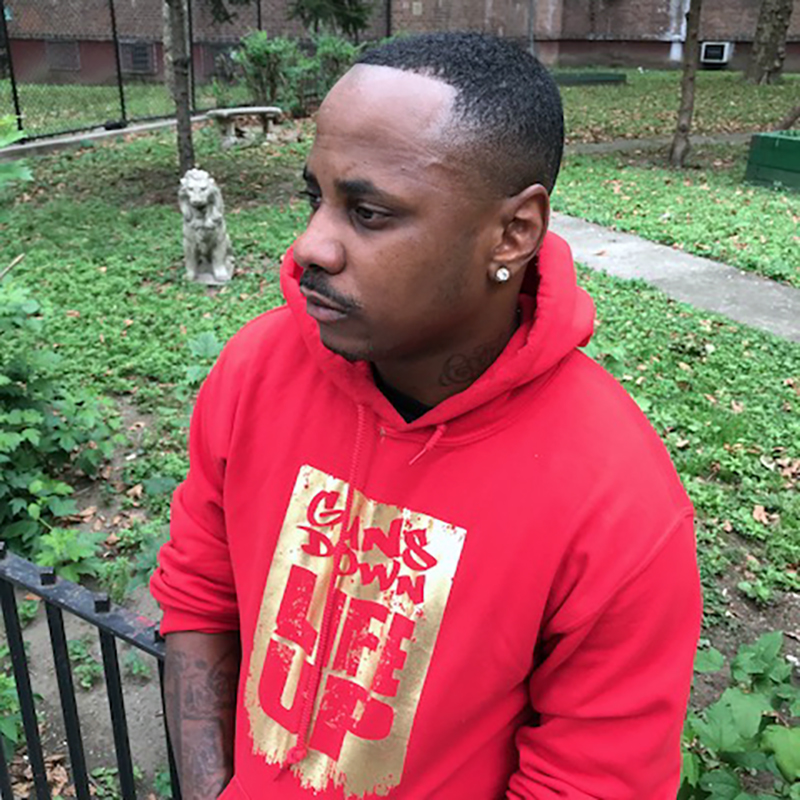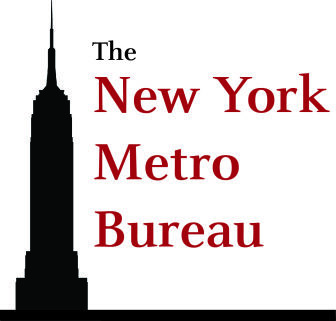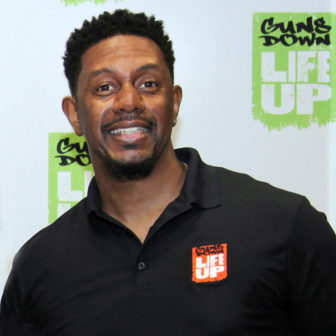
Photos courtesy of Lincoln Medical & Health Center
Performer Kartier Conway at the site where his son Ocean was shot.
NEW YORK — On one Thursday in March, James Dobbins was towering over a group of teen boys as they all headed to a community board meeting in the South Bronx. Dobbins is the assistant director of Guns Down Life Up, a program aimed at curbing gun violence among young men in the Mott Haven neighborhood.
 Dobbins is the right fit for a mentor. He looks tall and tough, but the way his smile makes his eyes crinkle tends to disarm. Sometimes he takes the group to the gym or to record music. But on that Thursday, he was asking them to talk about the program to Community Board 2 in the Hunts Point neighborhood.
Dobbins is the right fit for a mentor. He looks tall and tough, but the way his smile makes his eyes crinkle tends to disarm. Sometimes he takes the group to the gym or to record music. But on that Thursday, he was asking them to talk about the program to Community Board 2 in the Hunts Point neighborhood.
Before the presentation began, he got a beep from the pager on his belt, telling him he was needed elsewhere. Just a mile or so east, outside of the basketball court of Patterson Houses, a public housing development, Ocean Conway, 16, had been shot in the head. Dobbins quickly ordered an Uber to Lincoln Medical & Health Center in the Bronx, also about a mile away.
Dobbins isn’t a surgeon or a nurse. He doesn’t have a medical degree. His role at the bustling emergency room is a relatively new invention. Part of his job exists on Tuesdays and Thursdays, when he hangs out with boys after school in a recreation center at Lincoln. Together, they make music, design clothing, get involved in politics.
But when he gets paged, Dobbins considers himself a sort of firefighter who puts out emotional ones.
He finds credible messengers
When he got to the hospital that Thursday, he was greeted by a sea of angry people waiting in the 58,000-square-foot emergency room. Each year, more than 100,000 people are brought in, but the crowd was waiting for just one. They were trying to find out if their friend was going to die.
“The whole projects was there,” Dobbins says now. “A lot of kids with a lot of anger, who were yelling. Upset. Saying, ‘I can’t believe this crap is happening. Who did this?’”
There were at least 30 people in the hallways. But Dobbins was laser-focused. His eyes carefully scanned the room. He was looking for the person ready to retaliate, and maybe the person looking to finish the job.
“Everybody knows somebody who knows somebody. It’s a real sticky situation,” he said. “I want to make sure there’s no infiltrators or undercover spies.”
He sent out texts to other “credible messengers,” his contacts on the streets who might be able to help the crowd cool down. Most importantly, he looked for family.
Guns Down Life Up, an anti-violence program funded by New York City’s Department of Health and Hospitals, began in 2011 at Harlem Hospital. The goal was to both prevent gun violence and help friends and families in the wake of a gunshot wound.
Hospitals and their staff encounter gun violence more than any other city institution, and thus have a kind of responsibility to treat it before it starts, Dobbins said.
“The doctors are there to comfort the patients, the police officers come for the criminals,” he said. “But who’s there for that family member that’s traumatized? Who’s there for a young man that just saw his friend get shot?”
Focusing on gun violence prevention, not just the treatment of a gunshot wound, is a relatively new trend among health care professionals. The first hospital-based gun violence prevention program started in Oakland, Calif. in 1994, according to the Health Alliance for Violence Intervention. Now there are more than 40 hospital-based violence intervention programs registered under the Alliance. And an additional 50 programs in the United States are modeled after the cure violence model, started in Chicago in 2000, which encourages communities to treat violence as a health issue.
In New York City, there are four programs: Kings County Hospital has a Kings Against Violence Initiative, Jacobi Hospital in the Bronx has a program called Stand Up to Violence and Guns Down Life Up has expanded to both Harlem Hospital and Lincoln Medical Center in the South Bronx.
It’s hard to tell through data and statistics the exact impact a violence intervention program in a hospital has because crime as a whole has been on a downward trend in cities like New York and Chicago. Shooting incidents in the Bronx are down only 6% in the last two years, but down 83% over the last 25 years, according to the New York City Police Department’s most recent CompStat report. In 2019, there were 251 shooting victims in the Bronx, and a majority survived.
But someone who gets shot and survives is more likely to get shot again, Dobbins says, or loved ones of a gunshot victim are themselves likely to be shot. It’s often his job to find credible messengers, someone who might be capable of calming people down and keeping them from retaliating after they’ve watched a loved one suffer. The goal of a credible messenger is usually to keep an already volatile situation from escalating, Dobbins said.
Trauma surgeon Nicholas Caputo said that when friends or family members go out looking for the person who attacked their loved one, it often ends in more bloodshed, perpetuating a cycle of violence.
When he first started at Lincoln 10 years ago, he overheard a group of kids talking in the trauma bay, planning to go after the person who shot their friend.
“A few hours later, one of those kids came back and he was shot,” Caputo said. “And he died as well.”
After school
But Guns Down Life Up goes a step further than violence interrupters. As a form of prevention, Dobbins attempts to take the teens who could be most susceptible to violence off the street completely.
The 20-some kids from the South Bronx who meet in hospital conference rooms twice a week after school take classes on photography, how to build a fashion brand, how to record music in a studio. But Dobbins also sprinkles in more serious lessons, such as how to defuse a potentially violent or deadly situation, or how to help friends walk away from a confrontation.

James Dobbins is the assistant director of the nonprofit New York City group Guns Down Life Up.
In 2017, when the most recent data was available, the CDC reported that a majority of the 51 people who died of gun-related violence in the Bronx that year were black men. And nationwide, homicide is still the leading cause of death in African-Americans 1 to 19 years old and 20 to 44 years old.
Jonita Bell, a nurse at Lincoln, happily enlisted her grandson in the program last year. She knew he was no stranger to gun violence. She asked that he not be named because members of the after-school program have been ridiculed and she is afraid of what might happen to him.
She knows that one night, in the middle of the night, her 13-year-old grandson woke to what he thought was fireworks.
But they weren’t.
Three loud pops. He ducked his head out the window into the summer air. People were running away. He couldn’t see anything else. And soon the street quieted down. So he got back in bed, only to be woken again a half hour later to banging on his front door.
His uncle was on the other side. And his cousin was slumped around the uncle’s shoulders — covered in blood, a bullet lodged in his head. The uncle lurched into the kitchen, his son still dangling on his shoulders. He was looking for car keys to drive to the hospital.
They took off. They arrived at Lincoln Hospital’s Emergency Room just in time for doctors to able to save the cousin’s life.
Meanwhile, the boy went back to sleep.
The violence wasn’t shocking to him, he said. Not even at 13.
“We used to just be playing in the park, we heard gunshots, everyone circled the ambulance. It was just how things went,” he said.
But now 16, sitting in the same hospital that once saved his cousin, he is wearing a red hoodie that says “Guns Down Life Up.”
When his grandmother first forced him into the program, he sat in the corner silently as everyone was getting to know each other. He didn’t want new friends, he said. But then he took a photography class, and realized he liked taking pictures. And he liked audio engineering. And he liked designing T-shirts.
“I have too many things on my mind. I can’t even focus on one. Positive things.”
In the taxi
Ocean Conway played basketball at the Patterson Houses court most nights after school. When he started to head home from the court on a cold March 21, he saw two men he recognized. And then one of them pulled a gun.
He thrust his iPhone in front of his face to soften the blow of a bullet aimed at his head. It helped. The small sharp metal ricocheted and barely missed his brain.
An ambulance came. A medic wheeled him into the emergency room at Lincoln Medical Center. A nurse made a phone call.
Kartier Conway picked up. He was backstage, getting ready to tap dance in a theater on the Lower East Side. Soon he would be sprinting out of the lounge, hailing a taxi.
As Conway sat in traffic, he prayed.
“I just said God, please don’t take my son now. I’ve been through enough already in my life.”
Conway, 33, grew up in Harlem. He lost his father when he was 3 and his mother when he was 16. The year his mother died, Ocean was born.
“It was like a trade-off to me,” Conway said. “A little something that was precious.”
Conway is a talented tap dancer, the youngest to dance with Sandman Sims at the Apollo Theater. He thought he had raised his son outside the tragedy he grew up with.
As Conway went through the sliding doors of Lincoln Hospital, his thoughts had moved from prayer to retribution.
“I was thinking, ‘Who did this to my son?’” Conway said. “Nobody wants their kid to be hurt. It doesn’t matter what you preach, what you stand for. When it hits home …” his voice trailed off.
Then he saw James Dobbins.
Dobbins is a crusader for GDLU swag: black T-shirts, hoodies with a green swatch in the middle filled with the program’s logo. Similar to a hashtag, he thinks the T-shirts symbolize a movement, and he’s usually wearing one of them.
But that Thursday, he had on a long white medical jacket, a button-up and a tie — one he wouldn’t take off until 2 the next morning.
He recognized Conway. In fact, he knew him well. Conway also doubled as a credible messenger for Guns Down Life Up. Dobbins had given Conway T-shirts and hoodies to pass out at the dance lessons he taught at high schools. But now, Conway found himself on a completely different side of the program.
“People see the other side of things that I do, promotions, engaging kids, dance, music, fashion,” Dobbins said. “Now he’s seeing the sort of nuts and bolts of what I do. He’s a parent, and I’m just kind of being there, consoling him.”
Suddenly, Dobbins was glad he had decided to put on a tie that day. He looked credible, like a real hospital employee. And someone who could help Conway get to his son.
“It made him feel comfortable with me to see who I am, that I’m important,” Dobbins said. “‘Here let me escort you.’ And they let me go upstairs, so he saw I wasn’t really just Jim, James, Jimbo, whoever from the streets.”
Dobbins escorted him to the operating room. Conway wasn’t allowed in, but the father had to hear something to curb his anxiety. So Dobbins flagged down one of the doctors he knew. She told him exactly where the bullet had landed and that Ocean had been talking when he was brought in. He would likely survive.
‘I’m OK’
After 10 hours of surgery, Ocean did survive. But he wouldn’t wake up until weeks later, from a medically induced coma.
In that time, Conway realized he had to be his son’s voice. Guns Down Life Up helped. They held three rallies for Ocean while he was comatose.
“It helps,” Conway said. “My son would have been another kid that just got shot and no one would have known nothing about it.”
Police released photos of two suspects two weeks after the shooting, but didn’t make arrests until May.
This is the final tier of Guns Down Life Up’s efforts: offering support through recovery and making sure everyone is paying attention. The program offers resources for families on how to relocate if they are feeling threatened. They’ll hold vigils and run press campaigns.
For Conway, Dobbins was someone to talk to in the hospital, as he was waiting for his son to wake up.
One day, at the start of May, he did.
“I was sitting over him when he started talking to us,” Conway said. He’ll never forget what his son said when he opened his eyes. Ocean looked at him and said: “‘Dad, you look tired.”
“And I was like, ‘Oh, you tryna be funny.’” As he remembers this, Conway takes his flat-billed cap off for a moment, and wipes away a few tears.
“And he says, ‘You need to go get some sleep. I’m OK.’”





























